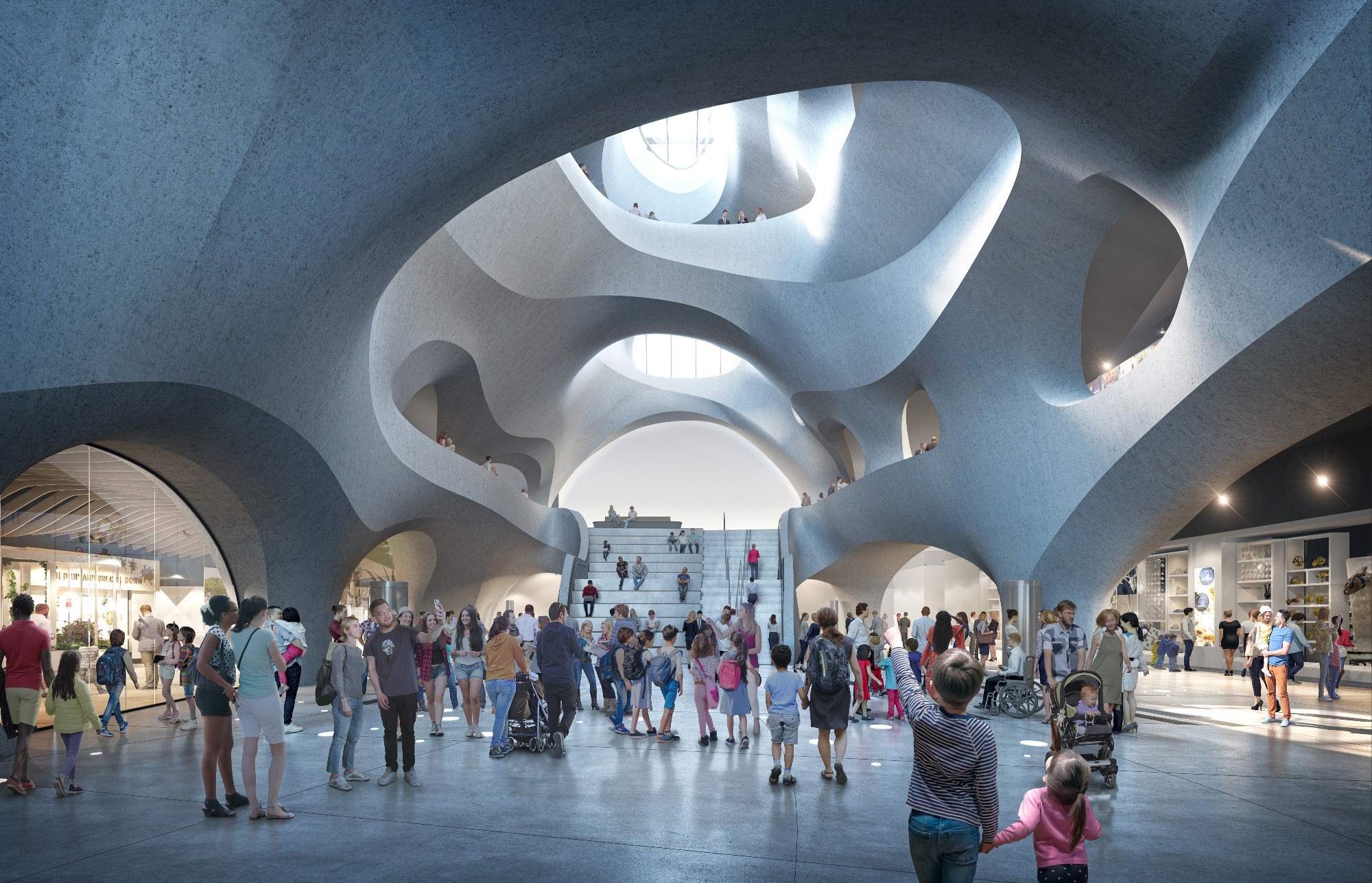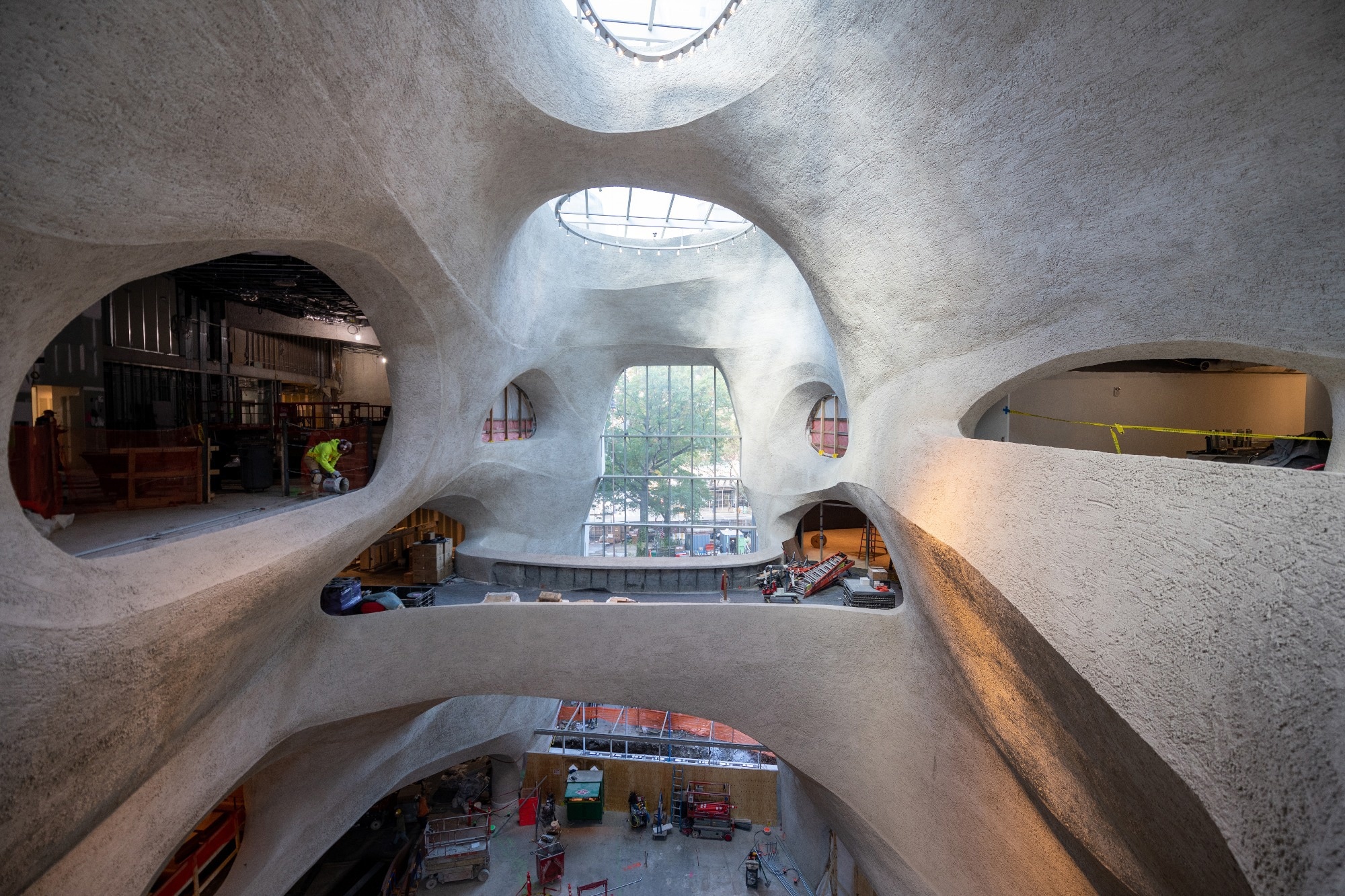A $383 million extension and renovation project for New York City’s Natural History Museum is nearing completion. The cave-like building, designed by US-based architecture firm Studio Gang, will improve visitor circulation and increase opportunities for public engagement with science.

The Kenneth C. Griffin Exploration Atrium, a soaring, four-story civic space that serves as a new gateway into the Museum from Columbus Avenue, flowing through the campus to create a visitor path from Theodore Roosevelt Park to Central Park West. Image Credit: Neoscape, Inc./© AMNH
Motivation for the Renovation
The American Museum of Natural History opened on Central Park West in New York City in 1877. Since then, the museum has grown with an eclectic collection of buildings added to its Manhattan campus. These range in styles from neo-Gothic to neo-Romanesque and neo-classical.
In 2015, the museum announced that it would commence works on an ambitious extension and renovation project to link these spaces together and improve the visitor experience with the Richard Gilder Center for Science, Education, and Innovation.
The Gilder Center, which is reported to cost $383 million, will support the museum’s ambitions to create new ways of learning about the natural world and share the excitement of science with the wider public. The focus of the project – on flow and visitor experience – is in response to a sharp rise in the museum’s popularity in recent years. It currently receives around five million visitors a year.

The Kenneth C. Griffin Exploration Atrium at the Richard Gilder Center for Science, Education, and Innovation, designed by Studio Gang, at the American Museum of Natural History. October 2022 construction view. View from the fourth-floor bridge looking west toward Columbus Avenue and Theodore Roosevelt Park. Image Credit: Timothy Schenck/© AMNH
To achieve flow and better visitor circulation, the building features a continuous space that conveys people east to west from a new Columbus Avenue entrance. The building is designed to facilitate the physical connection between different spaces in the museum, with connective bridges and openings leading visitors to the rest of the campus.
A four-story atrium will form the central zone of the new extension, where many of these connecting bridges and openings are exposed to view. The atrium will be filled with natural light, and also helps with air circulation throughout the whole museum complex.

Construction view of the fourth-floor bridge spanning the Kenneth C. Griffin Exploration Atrium inside the Richard Gilder Center for Science, Education, and Innovation, designed by Studio Gang, at the American Museum of Natural History. Image Credit: Timothy Schenck/© AMNH
The project will connect the 10 existing buildings on the museum campus for the first time. This was the original plan for the museum campus in the 19th Century.
The architects said that this design improves visitor circulation while creating opportunities for exploration and discovery. They state that natural daylight in the atrium and sight lines to the various spaces in the museum will facilitate the kind of flowing, explorative engagement with science that the museum sets out to encourage.

Designed by Studio Gang, the international architecture and urban design practice led by Jeanne Gang, the Richard Gilder Center for Science, Education, and Innovation project will feature an immersive experience that reveals the natural world through spectacular visualizations of scientific data, an insectarium dedicated to the most diverse group of animals on Earth, a permanent butterfly vivarium, a redesigned library, state-of-the-art classrooms, and more. The project also includes improvements to the adjacent portion of Theodore Roosevelt Park, with a new landscape design by Reed Hilderbrand that adds seating and gathering areas, expands circulation, revitalizes planting, and enhances park infrastructure. Image Credit: Neoscape, Inc./© AMNH
The project’s focus on the visitor experience and improving public science education stems directly from the museum’s core mission to spread interest and enthusiasm for science. This mission is also supported by initiatives like professional development training for teachers, school partnerships, out-of-school programs with authentic research experiences, and a graduate school for science educators. Demand for educational offerings like this has been growing consistently, and the new development will significantly increase the museum’s capacity to deliver science education for students, teachers, and families in New York.
Project Details
The extension and renovation works cover 230,000 sq ft, at a projected cost of $383 million.
The new atrium building on Columbus Avenue will provide the museum’s first universally accessible street-level entrance.
On the facade, Milford pink granite panels will surround glazing. Milford pink granite is also used in the museum’s iconic frontage on Central Park West. The new granite panels are shaped with a 3D cut that creates an undulating, contemporary facade. The architects state that the facade evokes geological layering, connecting it with the museum’s science education purpose.
Inside, the atrium walls continue the undulating effect cut into the granite panels of the facade. Along with walkway bridges and cut-out sections, the walls create an organic-looking interior.
This interior look is achieved largely through the application of shotcrete. Shotcrete is concrete sprayed onto shaped rebar, which cures to work as a structural component while creating a naturalistic, cavernous interior space. The process requires hand-finishing, which will further add to the organic feel of the extension’s interior.
The atrium connects a number of other spaces being renovated as part of this major development project. Among these is a research library, a “collections core” covering five stories, education rooms, an insectarium, and a vivarium housing over 80 species of live butterflies. Also underway is work on a permanent, immersive exhibition that explores different scales of life on Earth, Invisible Worlds. The new exhibition spaces were designed by Ralph Appelbaum Associates.

Test patterns projected by technicians working on Invisible Worlds, a 360-degree immersive science-and-art experience designed by Tamschick Media + Space with Boris Micka Associates, located in the Richard Gilder Center for Science, Education, and Innovation at the American Museum of Natural History. Image Credit: Timothy Schenck/© AMNH
The extension’s rear facade links with other buildings on the campus and features a large window with copper cladding. Landscape architects Reed Hildebrand are also renovating the current Theodore Roosevelt Park as part of this major project.
Studio Gang Next Steps
The Gilder Center project was selected as a winning entry in the 67th Annual Progressive Architecture Awards in 2020 and was also featured in the March 2020 edition of Architect Magazine.
Jeanne Gang, the founder of the Gilder Center’s architecture firm Studio Gang, also recently received a prestigious industry award, Le Prix Charlotte Perriand, for her work in architecture.
The final touches are being completed at the Gilder Center this winter. The American Natural History Museum plans to open the doors of the new development to visitors in February 2023.

The Kenneth C. Griffin Exploration Atrium, a soaring, four-story civic space that serves as a new gateway into the Museum from Columbus Avenue, flowing through the campus to create a visitor path from Theodore Roosevelt Park to Central Park West. Image Credit: Neoscape, Inc./© AMNH
References and Further Reading
Dreith, B. (2022). Photos show Studio Gang's Natural History Museum extension nearing completion. [Online] Dezeen. Available at: https://www.dezeen.com/2022/11/02/amnh-studio-gang-construction-new-york/
Richard Gilder Center for Science, Education, and Innovation at the American Museum of Natural History. [Online] Studio Gang. Available at: https://studiogang.com/project/gilder-center
Volner, I. (2015). Richard Gilder Center for Science, Education, and Innovation. [Online] Architect Magazine. Available at: https://www.architectmagazine.com/project-gallery/richard-gilder-center-for-science-education-and-innovation_o
Disclaimer: The views expressed here are those of the author expressed in their private capacity and do not necessarily represent the views of AZoM.com Limited T/A AZoNetwork the owner and operator of this website. This disclaimer forms part of the Terms and conditions of use of this website.